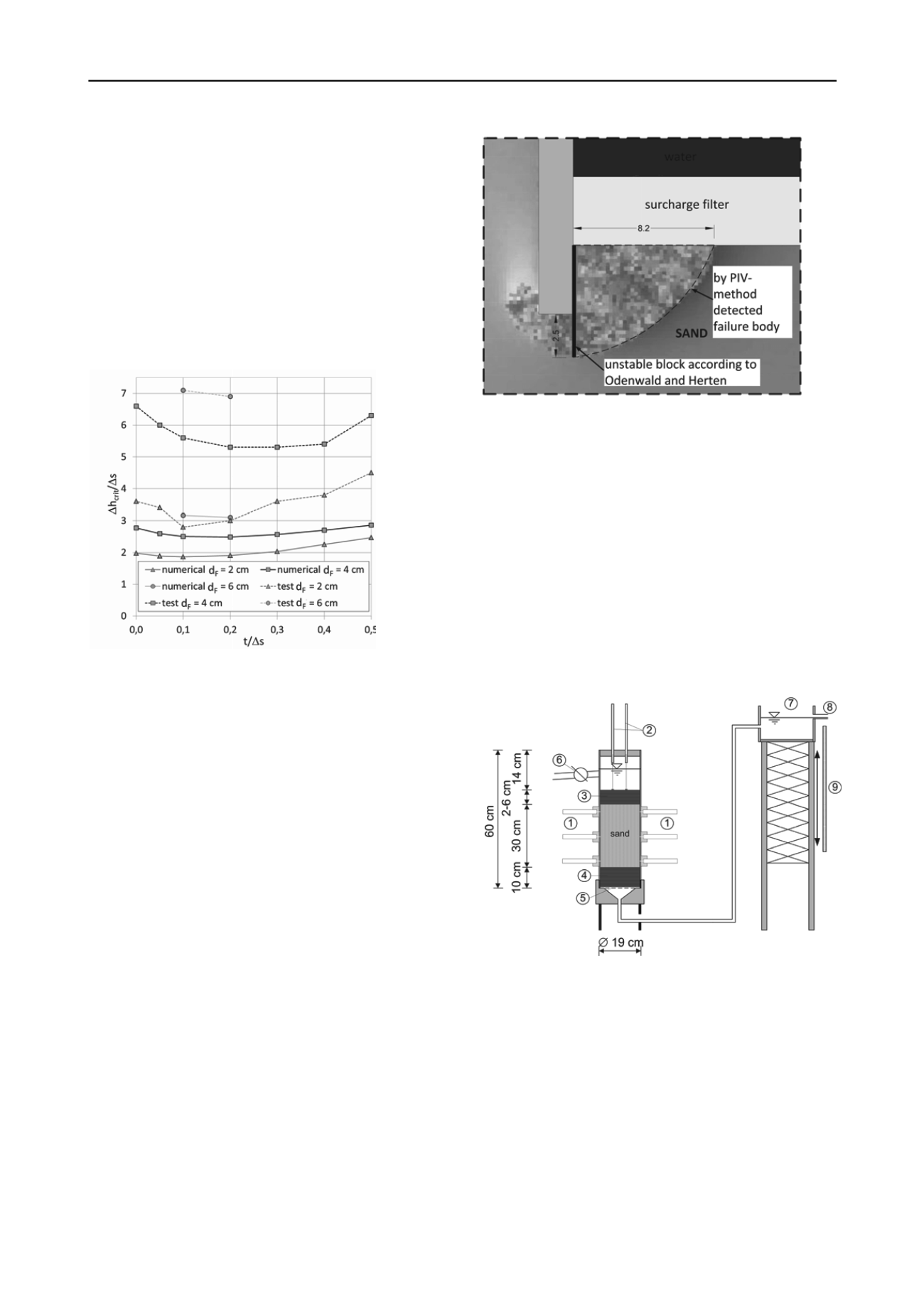
417
Technical Committee 101 - Session II /
Comité technique 101 - Session II
Proceedings of the 18
th
International Conference on Soil Mechanics and Geotechnical Engineering, Paris 2013
numerically calculated curves reach a minimum at a certain
ratio t/
s where the lowest critical potential differences
h
crit
arise for a constant thickness of the surcharge filter d
F
. Starting
from this minimum, further reduction of the embedment depth t
enables higher critical potential differences
h
crit
. The
laboratory experiments confirm the findings of the extended
theoretical approach of Odenwald and Herten.
However, the critical potential differences
h
crit
achieved
during laboratory tests are significantly higher than the critical
potential differences
h
crit
, calculated by Odenwald & Herten,
which lie on the safe side. Moreover, the difference between the
results of the experimental series and the theoretical approach
increases inversely proportionately with increasing thickness of
the surcharge filter (Figure 4).
Figure 4. Comparison of test results with the results of the
extended theoretical approach
Basically the difference between the numerical calculations
and the experimental test results is due to the highly simplified
unstable block, which is applied in Odenwald and Herten’s
calculation approach. Secondly, in the numerical calculations
only the weight of the sand and the surcharge filter was
recognized as retaining force, frictional forces were neglected.
It has to be kept in mind, that when installing a surcharge
filter on the pit bottom frictional forces are acting in the shear
zone of the surcharge filter and in the base material in critical
condition, too.
In addition, it was found out, that the size of the unstable
block increases with increasing surcharge filter thickness. Since,
in conventional procedures for verifying the safety against
hydraulic heave, the thickness of the surcharge filter is only
considered as additional weight in calculations, but with no
impact on the shape and size of the unstable block. These
methods do not offer any realistic result if a surcharge filter is
installed (Figure 5).
To achieve more realistic and therefore, more economic
calculation results, an approach that brings the unstable block
closer to the realistic failure body and also takes into account
the frictional forces in the surcharge filter and in the base
material has to be developed.
Figure 5. Comparison of test results with the results of the
extended theoretical approach
The observation of the experiments and the evaluation of
the results also showed that the thickness of the surcharge filter
has significant influence on the failure mechanism and shape of
the unstable block. In order to analyze the hydraulic heave with
surcharge filter more detailed, multiple uniaxial flow-tests were
carried out.
4 UNIAXIAL FLOWED SAND COLUMN
To analyze the influence of the surcharge filter thickness on the
hydraulic heave more detailed, numerous uniaxial flow-tests
were performed. For this purpose a specific apparatus was
designed to simulate uniaxial flow through a sand column
(Figure 6). A more detailed description of the test materials, the
construction of the test rig and the used measurement technique
is given in (Schober and Boley 2012).
Figure 6. Schematic of flowed cylinder: (1) water pressure
sensors, (2) displacement transducers, (3) surcharge filter, (4)
filter, (5) perforated plate, (6) water meter, (7) water supply, (8)
over fall, (9) staff gauge
The aim of the test series was, among other things, to
determine investigate the influence of the surcharge filter
thickness d
F
and the relative density D of the test material on the
critical hydraulic gradient i
crit
. The results of the uniaxial flow-
tests are used for a better understanding of the results of the
hydraulic heave experiments.
Altogether, 25 tests were carried out. The relative density
was varied between D = 0.1, 0.5 and 0.8. Moreover, the
surcharge filter was installed in different sizes, with a thickness
of d
F
= 1, 2, 3, 4, 5 and 6 cm. Tests without a surcharge filter
were carried out too. In the test series, different relative


